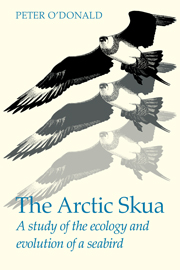Book contents
- Frontmatter
- Contents
- List of figures
- List of tables
- Preface
- 1 The Arctic Skuas of Fair Isle
- 2 Numbers and distribution
- 3 Feeding behaviour and ecology
- 4 Breeding ecology
- 5 Genetics
- 6 Demography and selection
- 7 Sexual behaviour
- 8 Sexual selection
- 9 Genetic models of sexual selection in birds
- 10 Mating preferences of the Arctic Skua
- 11 Conclusions
- Appendix A Rates of increase of bird populations
- Appendix B Analysis of variance of a 2 × r table with unequal numbers of observations
- Appendix C Statistical analysis of assortative and disassortative mating in polymorphic birds
- References
- Index
5 - Genetics
Published online by Cambridge University Press: 21 May 2010
- Frontmatter
- Contents
- List of figures
- List of tables
- Preface
- 1 The Arctic Skuas of Fair Isle
- 2 Numbers and distribution
- 3 Feeding behaviour and ecology
- 4 Breeding ecology
- 5 Genetics
- 6 Demography and selection
- 7 Sexual behaviour
- 8 Sexual selection
- 9 Genetic models of sexual selection in birds
- 10 Mating preferences of the Arctic Skua
- 11 Conclusions
- Appendix A Rates of increase of bird populations
- Appendix B Analysis of variance of a 2 × r table with unequal numbers of observations
- Appendix C Statistical analysis of assortative and disassortative mating in polymorphic birds
- References
- Index
Summary
Genetic analysis of matings between phenotypes
The first step in studying any polymorphism is to determine the genetics of the different phenotypes. At first sight, the polymorphism of the Arctic Skua seems to depend on a simple genetic mechanism. As adults, the pale, non-melanic birds are completely distinct from the dark and intermediate melanics. Dark and intermediate birds show a continuous range of phenotypic expression with no clearly definable difference separating darks from intermediates. Matings of pale × pale birds have only produced pale offspring. We may thus infer: (i) that pale birds are homozygous; and (ii) that melanism is semi-dominant to pale. If only two alleles determine the phenotypes, pales must be homozygous for the pale allele, while darks and intermediates are either homozygous or heterozygous for the alternative, melanic allele. Presumably the melanic homozygotes would tend to be darker than the heterozygotes.
Chicks produced by matings
A difficulty is encountered when classifying the chicks produced by matings of different phenotypes. The phenotypes of the chicks show no absolutely clear differences. All gradations can be observed, from pale chicks with a large patch of white feathers on their belly, to those with just a few white feathers, then to those with some darkening at the tips of the mainly white feathers, through intermediates with bands of dark pigment, and so to darks with completely dark belly feathers. Although there is this continuous gradation from pale to dark, the great majority of birds are easily classified by phenotype.
- Type
- Chapter
- Information
- The Arctic SkuaA study of the ecology and evolution of a seabird, pp. 100 - 119Publisher: Cambridge University PressPrint publication year: 1983

